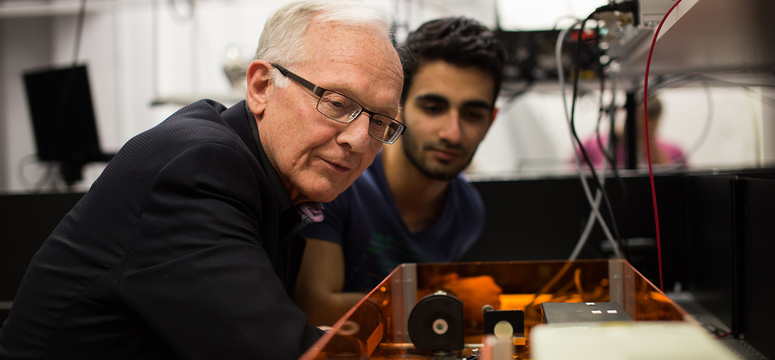We live in a time like no other — technology and visual communication are becoming increasingly entangled. Today’s teens and young adults are even colloquially referred to as the “selfie generation”!
Now, says Paul Corkum, professor in the University of Ottawa’s Department of Physics and this year’s featured speaker at the Annual Quantum Public Lecture, it turns out that even the things we can’t see — like molecules — are taking selfies.
The Annual Quantum Public Lecture has been the Institute for Quantum Science and Technology’s (IQST) hallmark event since 2010, and brings exciting speakers to campus to explore a range of quantum sciences and technologies. On Thursday, Nov. 24, Corkum takes to the stage to explain the science behind molecule selfies, laser X-rays, and harnessing the world’s shortest flashes of light.
World’s shortest flashes of light lead to important technological innovations
The laws of quantum physics eschew most of the classical laws of nature. Quantum physics is the scientific realm where something can be in two places at the same time, be two things at once, and even teleport across a city. Corkum specializes in ultra-short light-pulse generation, molecular imaging, and attosecond physics, to name a few. His work uses the interaction of intense, short, infrared light pulses with atoms or molecules to generate coherent soft X-ray radiation and attosecond light pulses.
Attosecond science opens the potential for new measurement methods. Attosecond pulses are fast enough to freeze-frame an electron moving in an atom. “Electrons are everywhere. They hold matter together; they power electronics. Changes in their behaviour give us light — even the laser,” Corkum says.
For context, an attosecond is to one second as a second is to the age of the universe.
“We have found a means of turning laser light into X-rays, and we have found a way of making the world’s shortest flashes of light. In fact, they’re the world’s shortest events that we can control. The duration of these flashes are measured in attoseconds or 1/1,000,000,000,000,000,000 (one quintillionth) of a second,” he explains. “This is amazing. It always impresses me when I say it.”
Corkum explains that his research team is developing very important new technology. “We can now make X-rays with lasers. In both technology and medicine, X-rays can see things that we do not see otherwise. With laser sources of X-rays, their uses will multiply.”
A molecule takes a selfie
The ability to measure these ultra-short bursts of light is particularly useful for measuring electrons, which are one of the particles at the core of quantum physics research.
Corkum describes producing an electron “selfie” as the subatomic equivalent of using a camera, or camera phone, to do the same.
“Imagine that intense light shines on a gas of molecules. If the force of the light wave is strong enough, one of the molecule’s electrons might break free and oscillate for the remainder of the light wave,” he explains. “The electron will bob — first away and then back, where it can collide with its parent molecule — including, with some probability, the part of the electron’s self that is left behind (the selfie)!”
If the two parts of the same electron collide, the electron “splashes” wildly, converting its energy of motion to X-ray light which Corkum records on a sensor similar to the sensor in a camera. The X-rays that he records contain a tomographic image of the electron. A computer translates the data into an image that can be seen, just as the computer in an everyday digital camera translates pixelated data into the selfie that social media users far and wide load on Facebook.
The audience at Thursday’s talk can expect an interesting and entertaining discussion, says Dennis Salahub, professor of theoretical chemistry and this year’s lecture host.
“Paul Corkum is a giant in the field of, well, strong fields, and fast laser pulses. I learn something of value every time I hear him speak. His talk will last about 3,600,000,000,000,000,000,000 attoseconds. It will be time well spent.”
The sold-out lecture will be held in the MacEwan Ballroom at 7 p.m. on Thursday, Nov. 24. Watch it live-stream.









